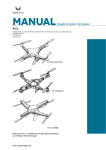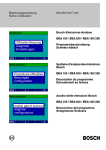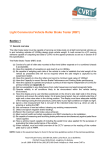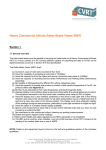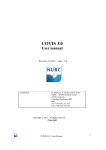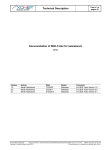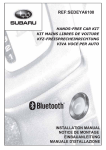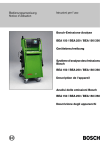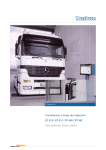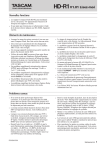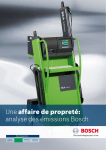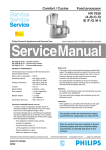Download Diesel Smoke Opacity Meter Specification
Transcript
DIESEL SMOKE OPACITY METER SPECIFICATION Definition and terms; A free acceleration – from idle, with no load on the engine, where the engine is accelerated against its own inertia by depressing the throttle pedal quickly and continuously (in less than one second) but not violently, so as to obtain maximum delivery. Trigger – the smoke meter recognises that a free acceleration is in progress and commences recording of the peak opacity achieved for a set period of time. EOBD - (European On-Board Diagnostics) European regulations which are the equivalent of OBD-II, with the same SAE J1962 diagnostic link connector and signal protocols being used. Zero check- the smoke chamber is checked and reset if necessary to ensure it has a value of 0.00 m-1 prior to the first free acceleration in the test procedure Section 1. 1.1 General overview (a) A Diesel Smoke Opacity Meter shall be provided that is capable of measuring smoke opacity as per the requirements of EU Directive 2014/45/EC. (b) The Diesel Smoke Opacity Meter test procedure shall meet the current vehicle inspection specifications for smoke meters (MOT/08/19/01 3rd revision 2007). See Appendix 1 for a summary of requirements. (c) The smoke tester must connect to a PC running software capable of outputting test data to CoVIS via the protocols as set out in Section 3 below. (d) The smoke meter must be able to capture the engine temperature, peak RPM and K mean value of opacity in all cases and return the values to CoVIS Page 1 of 12 Section 2. 2.1 General Specification The Diesel Smoke Opacity Meter shall have the capacity to; (a) Include an internal clock and calendar. (b) Detect a free acceleration automatically. (c) Record RPM in real time. (d) Record Engine temperature. (e) Connect an appropriate exhaust sampling probe. (f) Apply the correct test procedure to each vehicle type and category. (g) Operate and produce a print-out independent of CoVIS. (h) Clearly display the user screen showing prompts and readings for the duration of the test. (i) Operate correctly without any disturbance or interference from other radio frequencies and electromagnetic fields that are experienced in the test centre environment. (j) Notify the user at maintenance intervals and manage its maintenance log. 2.2 Clock and calendar The clock and calendar in the meter must have the following features; (a) EU format - dd/mm/yyyy and hh.mm. (b) Adjustable by user. (c) Summer / winter time adjustment. (d) 24 hour clock standard format. 2.3 Free Acceleration Detection Requirements A free acceleration trigger shall be induced by any of the following; (a) Minimum peak RPM (minimum accepted is twice the idle speed). (b) Smoke temperature increase in the measuring chamber. (c) Smoke pressure increase in the measuring chamber. Also (d) On detecting a free acceleration the maximum opacity reading shall be recorded for the duration of the free acceleration. NOTE - A trigger that is induced manually or by a change in opacity is not acceptable. 2.4 RPM Real Time Recording (a) A RPM measuring device as recommended by the manufacturer that is capable of measuring real time RPM on all vehicles, where no detectable delay or interference is observed must be connected to the meter. (b) An on-board diagnostic interface to EOBD standard must be provided that is capable of detecting RPM on vehicles that are EOBD Compatible. 2.5 Engine Temperature Recording (a) The Diesel Smoke Opacity Unit will have a temperature measuring device connected that is capable of measuring engine temperature on HCV and LCV Vehicles in degrees Celsius. (b) Where a device detects temperature using the engine oil (oil probe), it shall be capable of being inserted via the dipstick on LCV and HCV vehicles. It shall be adjustable in length so as to match the dipstick length. (c) Where such an oil probe is used, the operator shall be prompted to remove the oil probe once conditioning has been achieved prior to commencing free accelerations. (d) An On-board Diagnostic interface to EOBD standard must be provided that is capable of detecting engine temperature on vehicles that are EOBD Compatible. Page 2 of 12 2.6 Exhaust Sampling Probes The Exhaust sample probe(s) shall (a) Have, where applicable, the appropriate exhaust sample probe for each vehicle class and exhaust pipes of various shapes, sizes, outlet angles and positions. You must be able to position the sample probe effectively central in the exhaust pipe to the flow of exhaust gas in straight tailpipes and those with bends close to the tailpipe outlet. (b) Have a durable clamping device that ensures the probe is securely attached for the duration of the test. The device must be easy and quick to attach and disconnect such as a spring loaded clamp. (c) Maintain an effective path from exhaust to the measurement chamber that does not impede the flow of gases and will not allow any significant loss in the air pressure, temperature and opacity of the sample. (d) For use on HCV - have a provision to reach vertical stack or central exit exhausts with a probe that meets the Smoke Meter Manufacturers specification and where the probe can be inserted by the vehicle tester from a safe position. (e) Adjust timings in the test procedure that suit various exhaust probe pipe lengths used for the test e.g. a different sampling time or probe infill time may be required on different types of vehicles. (f) Ensure the length of exhaust probe and max temperature tolerance is to manufacturer’s specification only. Any modifications to the probes /extensions must be approved by the equipment manufacturer. 2.7 Test procedures (a) Vehicle type shall fall into two categories HCV or LCV and appropriate infill and sample timings shall adjust accordingly. (b) The smoke meter must be capable of dealing with the various test procedures for each category and vehicle type as set out in the relevant testers’ manual. (c) Carry out a zero check and reset if necessary prior to commencing initial free acceleration. (d) Check for any zero point drift that may have occurred during the complete test procedure. Excess of 0.1m-1 or +/-5% of the arithmetic mean or whichever is greater shall display an error and no result. (e) Automatically stop the test sequence if the measured value of the first acceleration is less than or equal to the fast pass smoke limit and produce a pass result – for any greater value the test shall continue on up to the maximum 6 accelerations. (f) Automatically stop the test sequence if the measured value of the first acceleration is greater than or equal to 9.99m-1 and evaluate the value with a fail result. (g) Pass / fail shall correspond to the limits applied by the RSA as per the vehicle tester’s manual 2.8 Standalone operation The smoke meter shall have the capability to (a) Operate independent of Covis (b) Store the test report on the local PC and make accessible for future review (c) Produce a printed report (see Appendix 2 for details) Page 3 of 12 2.9 Smoke meter display and location Where the vehicle tester is positioned in the standard driving position; (a) There shall be a clear and uninhibited view of the Diesel Smoke Opacity Meter screen, particularly in poor light conditions or bright sun light. (b) There shall be no requirement to acknowledge prompts after conditioning has completed and the last request for a free acceleration in the test procedure. (c) The Diesel Smoke Opacity Meter controls/keyboard that are not shared between lanes shall be located on the driver’s side. (d) When the smoke meter is installed, it must not inhibit overview of the CCTV camera or the reading of the number plate by the ANPR camera. NOTE; Detail on the equipment layout is found in the test lane guidelines section of the premises guidelines. 2.10 Environmental conditions and disturbances The Diesel Smoke Opacity Meter shall operate correctly and be to a durable standard that; (a) It is designed to have a minimum working life of 5 years in a test centre environment (this excludes any peripherals that are considered wear parts e.g. RPM pick up, oil temperature probes etc.) (b) It maintains its accuracy whilst in service – subject to the manufacturer’s maintenance and service schedule. (c) It will not emit any radio interference or radio disturbance that may interfere with any other test equipment in the test centre. (d) It will not allow any disturbance to be experienced from electromagnetic fields in the test centre, including the RPM and oil temperature instrumentation. (e) Should an interference arise at a test centre with other test equipment, the onus is with the equipment provider who most recently installed the offending equipment to resolve the issue. (f) A result will return as “void” should a test fail to complete due to a disturbance or interruption – example battery failure on mobile units or mechanical shock. This unsuccessful test will not return to Covis. The smoke test will have to recommence at the start of the procedure. (g) The battery life on a mobile unit shall have the capacity to complete at least two successive full HCV Tests with maximum free accelerations without a requirement to charge between tests. 2.11 Maintenance and cleaning (a) The accuracy of the Diesel Smoke Opacity Meter shall be verified at least once every week. The unit shall be prevented from operating if the verification is not carried out or is out of the manufacturer’s tolerance. (b) The service intervals shall be, at a minimum, set to the manufacturer’s recommendation and shall display the information and status clearly to the operator showing how many days are remaining. (c) The machine shall notify the user if the chamber or the optics require cleaning between service intervals and prevent further use until issue is resolved. Page 4 of 12 Section 3. 3.1 Connection to CoVIS (a) A host PC must be provided to communicate between the smoke tester and CoVIS. This PC must be capable of communicating to CoVIS via ASA network standard on a network i.e. requires a network card dedicated to communicate with CoVIS or the centre’s LAN (b) The PC must have the date and times set to match the Covis Admin Computer (c) The date and time format must be set to a standard Irish date\time format and time zone (d) There shall be no firewalls or firewall rules preventing data from transferring to\from ASANetwork (e) The Diesel Smoke Opacity Meter or its host must have the capability to receive test orders transmitted by CoVIS and return test results to CoVIS using the ASA network secure common industry standard interface - see example in Appendix 4 below. (f) The Diesel Smoke Opacity Meter shall have the capacity to electronically transmit test measurement values for peak RPM (measured in revolutions per minute) at the instance of recording peak opacity - see the highlighted content in Appendix 4. (g) The Diesel Smoke Opacity Meter shall have the capacity to electronically transmit a test measurement values of the engine temperature achieved (measured in °C) prior to the initial free acceleration - see the highlighted content in Appendix 4. (h) The Diesel Smoke Opacity Meter must be capable of returning the mean value of opacity, based on the rules set out in Appendix 4 below. (i) The unit of opacity returned will contain the calculated mean value in K m-1. (1/m) (j) The Diesel Smoke Opacity Meter must provide a start date / time for each test. (k) The Diesel Smoke Opacity Meter must provide an end date / time for each test. (l) The Diesel Smoke Opacity Meter must provide the serial number of the equipment used for each test. . 3.2 Input Test order detail from CoVIS (a) Use the standard ASA network requirements input data. (b) CoVIS sends the following for all test orders: (i) Order type id (ii) Order Description (iii) Reg No, (iv) EU Vehicle Category (v) Date of first registration (vi) No Axles (vii)Fuel Type (c) The Smoke Meter must be capable of receiving data inputs from CoVIS and altering the test procedure based on date of first registration and fuel type received. Page 5 of 12 Section 4. 4.1 Documentation/Identification (a) The Diesel Smoke Opacity Meter shall have a durable identification mark on its exterior or its control unit showing the make, model and serial number. (b) The manufacturer of the Diesel Smoke Opacity Meter shall provide a clear and easy to understand user manual, written in English and available at any time to the test centre, which shall explain how it operates and the function of each aspect of the unit including the RPM and engine temperature measuring devices. (c) The manufacturer of the Smoke Opacity Meter shall provide a recommended "maintenance procedure". Note; Valid and current calibration certificates shall be scanned and uploaded to CoVIS. An original hard copy shall be stored securely and made accessible for inspection for 12 months. Section 5. 5.1 Calibration of Smoke Opacity Meter and engine observation devices (a) The calibration service provider, as part of their quality programme, shall adhere to the CITA 9B Quality Requirements (see Appendix 3). (b) The manufacturer of the Diesel Smoke Opacity Meter shall, if requested, provide a technical handbook in English with a description of the calibration technology for review. (c) The calibration procedure shall match the manufacturer’s recommendation. (d) For an initial set up, the installer shall provide a calibration certificate. (e) A competent person shall calibrate the equipment every 12 months, or more frequently if required, using equipment to a standard specified by the manufacturer. (f) The temperature measuring device shall be capable of measuring engine temperature with an accuracy of +/- 5% relative and equivalent to an indicated oil temperature of up to at least 90° C and suitable for HCV and LCV vehicles – details on how this is verified must be documented. (g) The engine speed (RPM) measuring device shall be capable of measuring engine speed with an accuracy of +/- 5% relative and equivalent to an indicated stable RPM of approximately 2000 rpm for an uninterrupted sampling time of 10 seconds. The reaction time to a change in RPM shall be <=500ms and suitable for HCV and LCV vehicles – details on how this is verified must be documented. (h) A condition report will be carried out by a competent person at 12 month intervals or if the unit is potentially damaged in any way (it may be carried out at time of calibration). Particular attention shall be made to the following and noted; (i) Cabling for RPM and engine temperature measuring devices are not excessively twisted, damaged or frayed. (ii) Connection points are not worn and are securely plugged in. (iii) 230V electric supply cabling meets current Irish electrical safety standards. (iv) Exhaust probe meets manufacturer’s specification for LCV testing (where appropriate). (v) Exhaust probe meets manufacturer’s specification for HCV testing (where appropriate). (vi) Hose length and internal diameter meets manufacturer’s specification. (vii) Hose is continuous from probe to measuring head and is free of pipe joiners and repairs. (viii) Probe and hose are free of carbon build up internally. (ix) Hose connections to the probe and the opacity measuring head are sufficiently secure and sealed ensuring there is no leakage of the smoke sample taken during the test. (x) Time and date is in EU format and synchronised to the nearest minute with the central CoVIS computer. Page 6 of 12 Appendix 1. Smoke Test Procedure and Calculations of Mean Value (ref; Directive 2014/45/EU) Limits are subject to change by the RSA in line with the Directive. Where the date of first registration of the vehicle is prior to 1st July 2008 There are two categories with different limits; Turbo; max limit mean value of 3.0 k m-1 Non Turbo; max limit mean value of 2.5 k m-1 Testing rules; There must be at least one pre-test blow out acceleration. There must be at least three free accelerations with a maximum of six allowed. Test is concluded and passed on the mean value of the last three valid accelerations if the value is below the category limit. In the case of HCV testing a gap of at least 10 seconds between the release of the accelerator and the prompt to carry out the next acceleration from idle is required. Where the date of first registration of the vehicle is on or after 1st July 2008 There is only one category with a max limit of 1.5 k mean Testing rules; There must be at least one Pre-test blow out acceleration. There must be at least one free acceleration and six is the maximum allowed. Test is concluded and passed on less than three valid accelerations if reading is below 1.5 k m-1. Test is aborted and failed on first valid acceleration if reading exceeds 9.99 k m-1. Where no valid mean value has been achieved a ‘void’ result will be returned. In the case of HCV testing a gap of at least 10 seconds between the release of the accelerator and the prompt to carry out the next acceleration from idle is required. Page 7 of 12 Appendix 2 Printout report Key Points; (a) The test values on the print out report must match the data values returned to ASA network for CoVIS i.e. where a K mean value is calculated and presented with two decimal places. (b) The K mean value will be rounded down to two decimal places. (c) The printout shall display the Peak Engine Speed in RPM. (d) The printout shall display the Engine Temperature in Degrees Celsius. (e) The printout shall display the Calculated K mean Value in m-1 set to 2 decimal places. (f) The RBT shall have the capability to operate independent of Covis and produce a printed report. The Printout must include at minimum the following details on the report. Test Centre Details – Name / Address / Centre number Completion time and date of test – dd/mm/yyyy - hh/mm Vehicle Registration – Registration Number Date of First Registration Vehicle category – HCV or LCV Test Category - Turbo / Non Turbo / Fast Pass Engine temperature - °C Peak RPM - max engine RPM K mean value – measured in m-1 set to 2 decimal places Test limit applied - value in 0.00 Outcome of the test – Pass / Fail / Void / Aborted Provision for CVR tester’s signature and tester number issued by the RSA Page 8 of 12 Appendix 3 CITA 9B Quality Requirements Covering Calibration 6.3. Calibration 6.3.1 The inspection body shall ensure that there are proper arrangements to adequately control and calibrate vehicle inspection equipment before and during use, in order to ensure its accuracy, its conformity to the relevant requirements and its continued suitability and to provide confidence in decisions based on measurements. 6.3.2 The calibration procedures, sometimes known as calibration programmes, shall define the calibration processes, their environmental conditions, their frequency, the acceptance criteria and the action to be taken when the results are found unsatisfactory and/or inadequate. 6.3.3 Quality relevant vehicle inspection equipment shall be calibrated before first use and at least at the following frequencies during in-service use or at other frequencies as prescribed in national regulations: NOTE; All calibration frequencies mentioned in the CITA requirements have been omitted from this Appendix as they are superseded by the prescribed calibration frequencies outlined in the Premises & Equipment Guidelines. 6.3.4 Calibration shall be done, where appropriate, against certified equipment having a known and traceable relationship to internationally or nationally recognised standards. Where no such standards exist, the basis used for calibration shall be fully documented, according to the equipment manufacturer's recommendation, if any. 6.3.5 If vehicle inspection equipment is found to be out of calibration or there are any other systematic errors, the validity of the vehicle inspection results since the date of last calibration shall be reassessed. If there was any relevant non-conformity, the vehicle inspection body shall, as soon as practicable inform the owners/keepers of the affected vehicles and invite them immediately for reinspection, making it clear that there will be no charge for the inspection. 6.3.6 The calibration status shall be shown clearly on relevant vehicle inspection equipment, preferably by means of suitable markers or labels, indicating at least the date of the last calibration and the date the next calibration is due. 6.3.7 Reference measurement standards held by the inspection body shall be used for calibration only and not for other purposes. Only competent bodies who can provide traceability to international or national measurement standards shall calibrate reference measurement standards. 6.3.8 The inspection body shall keep records of all calibrations performed. Page 9 of 12 Appendix 4 Sample XML Stream sent to CoVIS from ASANetwork Important Note o o o o o o o o o o The highlighted content in the sample below shows the minimum fields required The data must be returned to ASANetwork in the correct format All XML must be valid or will be rejected The sample file contains results for 3 gas blasts XML should output all raw data including decimal values The results must relate to the test Order ID received from CoVIS The registration number is not read when processing the results All values highlighted below must be returned Results are matched to the test order id sent to the manufacturer Only the calculated Mean value for Opacity is taken. SAMPLE ONLY <?xml version="1.0" encoding="ISO-8859-1" standalone="no" ?> <!DOCTYPE RESULTS SYSTEM "awnres.dtd"> <!-- Created 07.08.2014 15:48:11 with AWNX32.dll Version 1.6.0 Build 45 --> <RESULTS> <RESULTSHEADER> <COUNTRY> <REGULATION>GERMAN</REGULATION> <LANGUAGE>GERMAN</LANGUAGE> </COUNTRY> <CUSTOMER> <!-- Kundeninformation --> <NAME> </NAME> <ADDRESS>ROSKEEDA ROSMUC</ADDRESS> <ZIP>N1</ZIP> <CITY></CITY> <TEL>00</TEL> <FAX></FAX> <CUSTNO></CUSTNO> <ORDER>650003511</ORDER> <EMAIL></EMAIL> </CUSTOMER> <VEHICLE> <IDENT> <!-- Fahrzeuginformation --> <REGISTRATION>05-OX-1740</REGISTRATION> <MANUFACTURER>VolkZwagen</MANUFACTURER> <MODEL>CUDDY</MODEL> <KEY2></KEY2> <KEY3></KEY3> <VIN>WV1ZZ2KZ5X057821</VIN> <FUEL1>DIESEL</FUEL1> <EMISSIONCODE></EMISSIONCODE> <PRODUCTIONDATE></PRODUCTIONDATE> </IDENT> <DATA> <ODOMETER></ODOMETER> <DIESEL_GT_35>--</DIESEL_GT_35> <REGISTRATION_DATE>22/03/2005</REGISTRATION_DATE> </DATA> </VEHICLE> </RESULTSHEADER> <RESULT OBJECT="EMISSION" METHOD="SMOKE"> <TITLE>Abgasuntersuchung</TITLE> <HEADER> <EQUIPMENT TYPE="CONTROL"> <TITLE>Bedienerführung</TITLE> <MANUFACTURER>XXXX</MANUFACTURER> <MODEL>XXXXX</MODEL> <VERSION>V 6.00/1.8.GB Leitfaden --</VERSION> </EQUIPMENT> <EQUIPMENT TYPE="SMOKE"> <TITLE>Abgastester</TITLE> <MANUFACTURER>xxxx</MANUFACTURER> <MODEL>xxxxxx</MODEL> <VERSION> V 1.00/1 c</VERSION> <SERIAL_NO>533479</SERIAL_NO> </EQUIPMENT> <START_TEST>07/08/2014 15:48</START_TEST> Page 10 of 12 <END_TEST>07/08/2014 15:48</END_TEST> <CONTROL_NO></CONTROL_NO> <RESPONSIBLE_OPERATOR> <NAME></NAME> </RESPONSIBLE_OPERATOR> <OPERATOR> <NAME>optimuso hara</NAME> </OPERATOR> <COUNTRY> <REGULATION>Ireland</REGULATION> <LANGUAGE>English</LANGUAGE> </COUNTRY> </HEADER> <SECTION OBJECT="REPAIRED_DEFECTS"> <TITLE>Behobene Mängel</TITLE> <DEFECT OBJECT="NONE"> <TITLE>Keine Reparatur</TITLE> <MEAS OBJECT="NONE"> <TITLE>Sichtprüfung ok</TITLE> <VALUE RESULT="1" SOURCE="HAND">i.O.</VALUE> </MEAS> </DEFECT> </SECTION> <SECTION OBJECT="DEFECTS"> <TITLE>Mängel</TITLE> <MEAS OBJECT="REPAIRED_DEFECTS_NO5"> <TITLE>Mängel nach Nr.5 der AU-Richtlinie, die behoben wurden Mängel-Nr.813 der HU-Richtlinie:</TITLE> <VALUE RESULT="1" SOURCE="HAND">i.O.</VALUE> </MEAS> <MEAS OBJECT="DEFECTS_NO6"> <TITLE>Erkannte, aber nicht behobene Mängel nach Nr.6 der AU-Richtlinie:</TITLE> <VALUE RESULT="1" SOURCE="HAND"></VALUE> </MEAS> </SECTION> <SECTION OBJECT="CONDITIONING"> <TITLE>Konditionierung</TITLE> <MEAS OBJECT="OILTEMP"> <TITLE>Öltemperatur</TITLE> <VALUE RESULT="1" LOWLIM1="0" UNIT="degC">67</VALUE> </MEAS> <MEAS OBJECT="IDLE_SPEED"> <TITLE>Leerlaufdrehzahl</TITLE> <VALUE UNIT="rpm" RESULT="3" LOWLIM1="500" HIGHLIM1="1200">820</VALUE> </MEAS> <MEAS OBJECT="CUTOFF_SPEED"> <TITLE>Abregeldrehzahl</TITLE> <VALUE UNIT="rpm" RESULT="3" LOWLIM1="2250" HIGHLIM1="6500">3500</VALUE> </MEAS> <MEAS OBJECT="CLEANING_GAS_BLASTS"> <TITLE>Anzahl Konditionierungsgasstöße</TITLE> <VALUE>0</VALUE> </MEAS> <SUMMARY> <TITLE>Konditionierung</TITLE> <MEAS OBJECT="CONDITIONING"> <TITLE>Konditionierung</TITLE> <VALUE RESULT="3">n.i.O.</VALUE> </MEAS> </SUMMARY> </SECTION> <SECTION OBJECT="GAS_BLAST"> <TITLE>Gasstoßmessung</TITLE> <MEAS OBJECT="TIME"> <TITLE>Meßzeit</TITLE> <VALUE UNIT="s">0.70</VALUE> </MEAS> <MEAS OBJECT="PROBE"> <TITLE>Sondenausführung</TITLE> <VALUE>1</VALUE> </MEAS> <STEP NO="1"> <TITLE>Gasstoß Nr.1</TITLE> <MEAS OBJECT="OPACITY"> <TITLE>Trübung</TITLE> <VALUE UNIT="1/m">0.40</VALUE> </MEAS> <MEAS OBJECT="IDLE_SPEED"> <TITLE>Leerlaufdrehzahl</TITLE> <VALUE UNIT="rpm" RESULT="1" LOWLIM1="500" HIGHLIM1="1200">820</VALUE> </MEAS> <MEAS OBJECT="CUTOFF_SPEED"> <TITLE>Abregeldrehzahl</TITLE> <VALUE UNIT="rpm" RESULT="1" LOWLIM1="2250" HIGHLIM1="6500">3500</VALUE> </MEAS> <MEAS OBJECT="ACCEL_TIME"> <TITLE>Beschleunigungzeit</TITLE> Page 11 of 12 <VALUE UNIT="s">0.94</VALUE> </MEAS> <SUMMARY> <TITLE>Gasstoß Nr.1</TITLE> <MEAS OBJECT="GAS_BLAST"> <TITLE>Gasstoß Nr.1</TITLE> <VALUE RESULT="1">bestanden</VALUE> </MEAS> </SUMMARY> </STEP> <STEP NO="2"> <TITLE>Gasstoß Nr.2</TITLE> <SUMMARY> <TITLE>Gasstoß Nr.2</TITLE> <MEAS OBJECT="GAS_BLAST"> <TITLE>Gasstoß Nr.2</TITLE> <VALUE RESULT="3">nicht bestanden</VALUE> </MEAS> </SUMMARY> </STEP> <STEP NO="3"> <TITLE>Gasstoß Nr.3</TITLE> <SUMMARY> <TITLE>Gasstoß Nr.3</TITLE> <MEAS OBJECT="GAS_BLAST"> <TITLE>Gasstoß Nr.3</TITLE> <VALUE RESULT="3">nicht bestanden</VALUE> </MEAS> </SUMMARY> </STEP> <MEAS OBJECT="OPACITY"> <TITLE>Trübungs-Mittelwert</TITLE> <VALUE RESULT="1" HIGHLIM1="3.00" UNIT="1/m" TYPE="AVG">0.40</VALUE> </MEAS> <MEAS OBJECT="OPACITY"> <TITLE>Trübungs-Bandbreite</TITLE> <VALUE RESULT="1" HIGHLIM1="-.--" UNIT="1/m" TYPE="DELTA">-.--</VALUE> </MEAS> <SUMMARY> <MEAS OBJECT="GAS_BLAST"> <TITLE>Gasstösse</TITLE> <VALUE RESULT="3">n.i.o.</VALUE> </MEAS> </SUMMARY> </SECTION> <SUMMARY> <TITLE>Gesamtergebnis</TITLE> <MEAS OBJECT="SMOKE"> <TITLE>Abgasuntersuchung</TITLE> <VALUE RESULT="1">bestanden</VALUE> </MEAS> <MEAS OBJECT="PERMISSION"> <TITLE>Plakette</TITLE> <VALUE RESULT="3" SOURCE="HAND">nicht erteilt</VALUE> </MEAS> </SUMMARY> </RESULT> </RESULTS> Page 12 of 12












